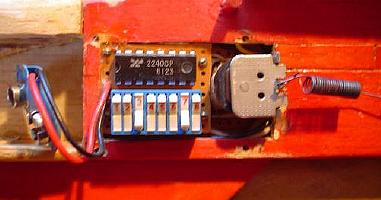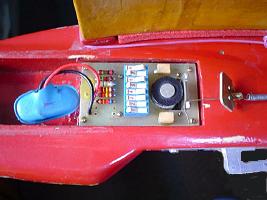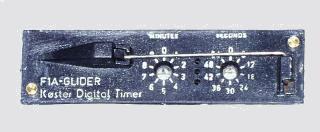 |
 |
|
Bauer V1.
|
Bauer V2.
|
Ken Bauer made his first F1A timer in 1977 and flew it at the 77 US Nationals. It was fitted to a circle tow model and used the tow hook movement to operate the timer start/reset switch. All Ken's electronic timers have worked this way. This arrangement offers a clear advantage by preventing loss of the model if the towline breaks. Unlike a mechanical timer, which cannot be reset after the model is in the air, the electronic timer is arranged to start whenever the towline goes slack and to reset back to zero when the towline comes tight again. The effect is that the model will always d/t regardless of whether it was launched normally, the line broke, or the flier lost his grip on the towline. Ken and Andy Bauer were the first to recognize this as one of the big reasons for using electronic timers.
The second reason that electronic timers made an early appearance in towline gliders was that, unlike the other classes, gliders need nose weight. F1A gliders often need ballasting up to the minimum weight: hence the additional weight of batteries was not a disadvantage.
Ken discovered Thomas Koster's first F1A timers when he was in Denmark in 1978, serving a mission for the LDS church, and paid Thomas a visit. He doesn't know when Thomas made these timers, but they were started by a switch operated by a conventional start line attached to the tow ring just like a clockwork timer. In consequence, while they offered improved accuracy, they did not provide protection against line breaks. Ken explained to Thomas why he should use a reset switch on the tow hook and the rest is history.
Ken returned to the US in early 1980 and resumed development of the timers. That's when his timers became generally available.
 |
 |
|
Bauer V1.
|
Bauer V2.
|
The first F1A timer that was built and packaged commercially was the Koster single function timer, which came out in early 1983.
 |
|
Koster F1A timer. |
This was a single function F1A circle tow glider timer, settable in 6 sec increments up to 9 min 54 secs and designed to be set/reset from a micro switch that detected when the tow hook was pulled forward. It used potted, waterproof electronics behind a plastic faceplate which contained a charging socket. A custom solenoid was used to release the d/t lever. There was no off switch: these timers drew so little current, 300 uA with a 5 cell battery pack or 80 uA with a four cell pack, when idle that a switch would have been just something else to go wrong. The timers were supplied complete with micro-switch and 50 mAh NiCd battery pack, ready to install and use. A custom charger, capable of charging up to three timers or battery packs at once, was also available. A feature of this charger was that it charged at a 1% rate, so could never overcharge the battery. This was a good feature because it meant that when you got home from flying you simply put the models on charge and left them charging until you went flying again.